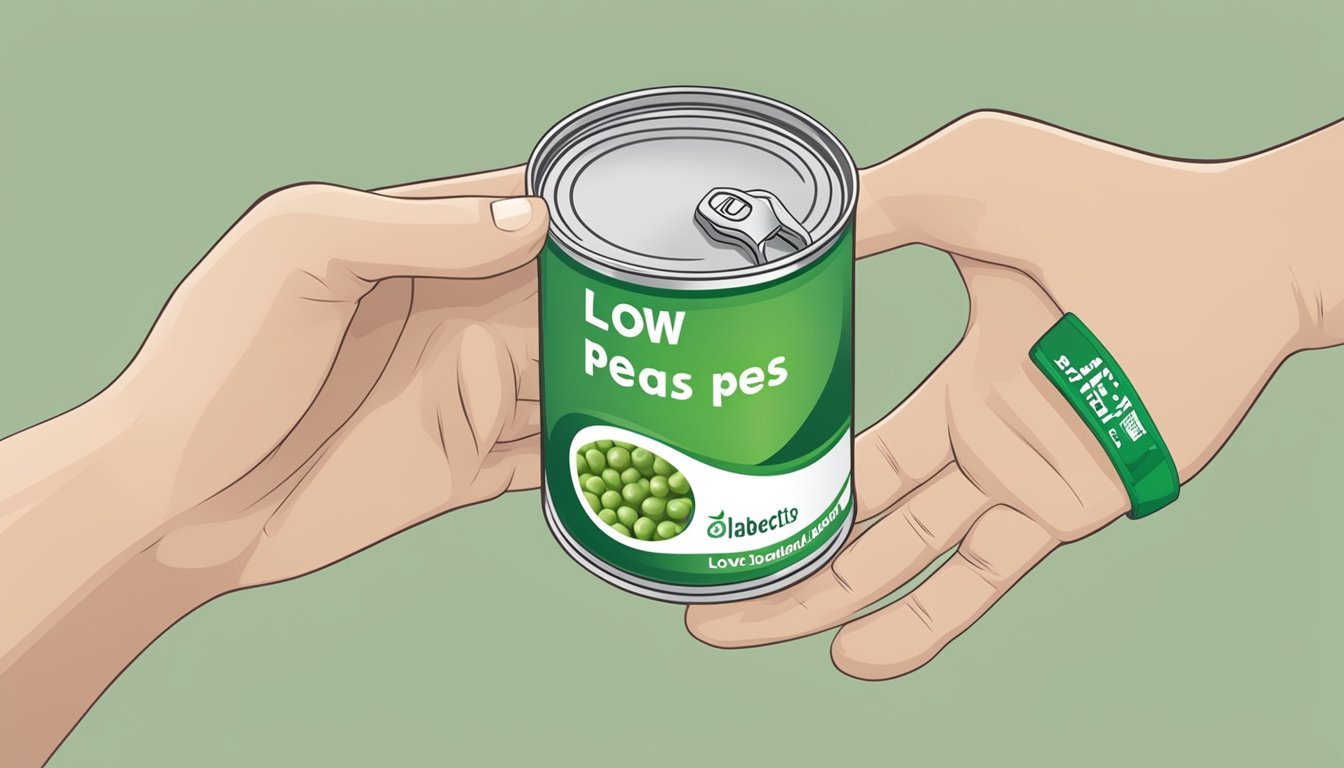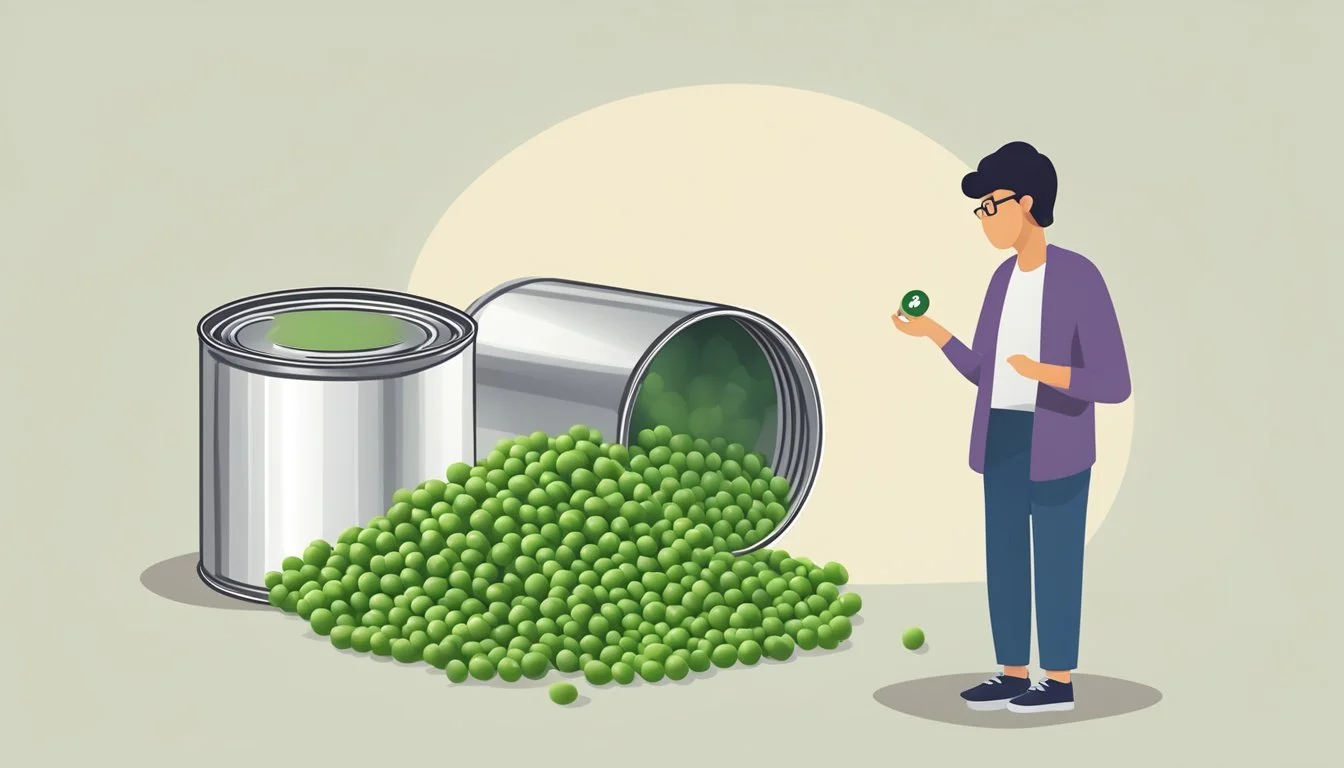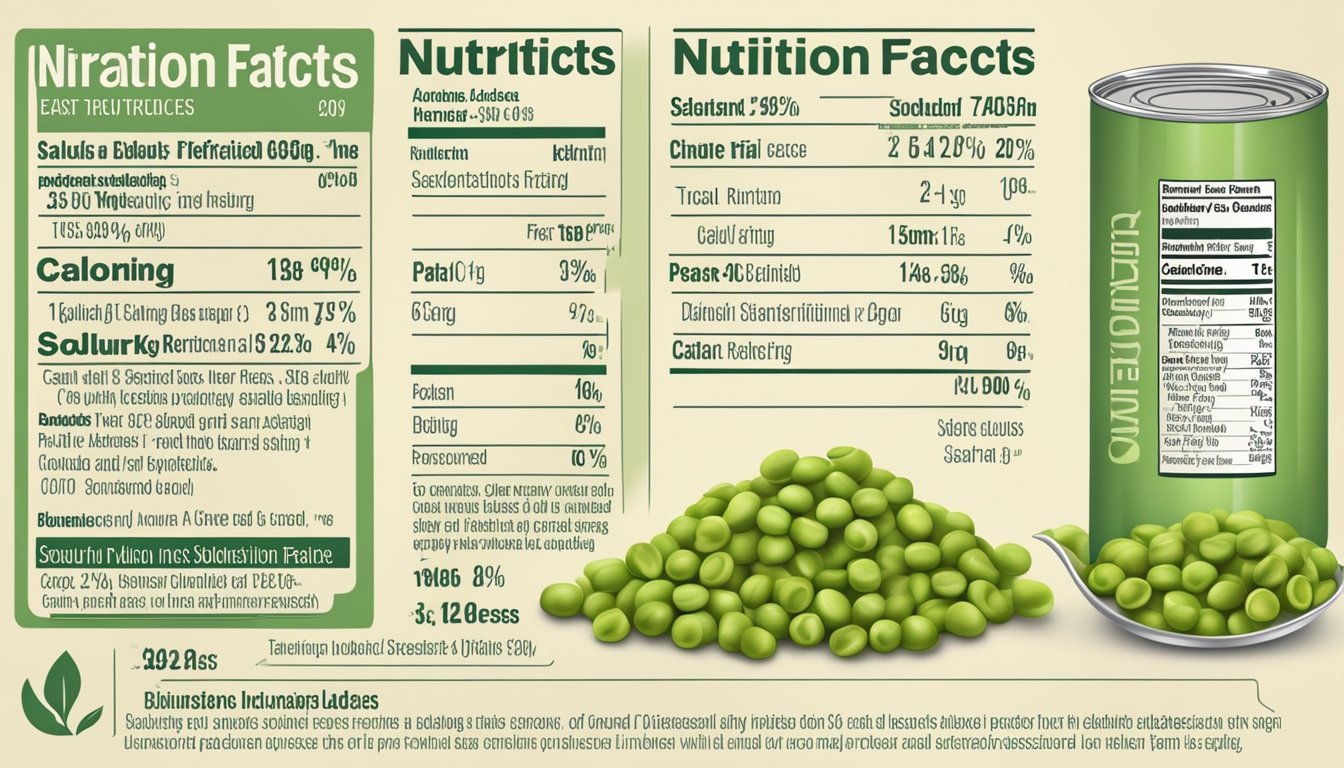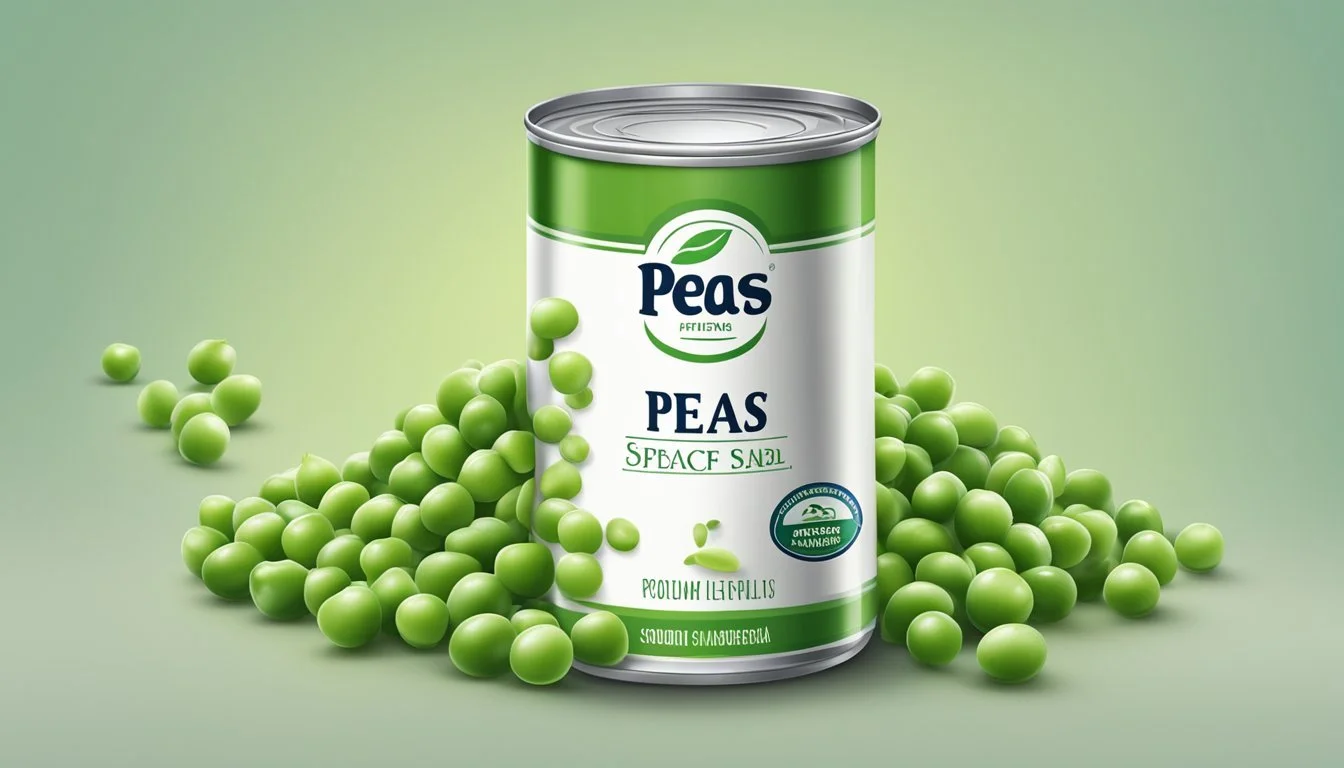Can Diabetics Eat Canned Peas with Added Sodium?
Nutritional Insights and Health Tips
For those managing diabetes, understanding the impact of various foods can make a significant difference in maintaining stable blood sugar levels. Canned peas, a common pantry staple, are no exception. They offer several nutritional benefits, with notable levels of dietary fiber and a low glycemic load. Diabetics can eat canned peas with added sodium, but they should be cautious about the sodium content.
When considering canned peas, the added sodium is an important factor to monitor, as excessive sodium intake can impact blood pressure and overall heart health. This is particularly significant for people with diabetes, who are at higher risk for cardiovascular issues. Opting for low-sodium versions or rinsing canned peas before consumption can help mitigate this concern.
Peas themselves are low in saturated fat, provide a good source of plant-based protein, and are rich in essential nutrients. Including them in a balanced diet can support overall health while managing diabetes effectively.
Understanding Diabetes
Diabetes affects how the body processes blood sugar and requires careful attention to diet. Managing carbohydrate intake and understanding insulin resistance are critical aspects.
Impact of Diet on Diabetes
Diet plays a crucial role in managing diabetes. Foods high in carbohydrates can raise blood sugar levels significantly. Monitoring carbohydrate intake is essential for diabetics to maintain stable blood sugar levels.
Diabetics often benefit from high-fiber foods, as fiber can help regulate blood sugar. For example, peas are high in dietary fiber. Choosing foods with a low glycemic index, like peas, can minimize spikes in blood sugar.
Consuming a balanced diet that includes protein, healthy fats, and low-sodium options can support overall health. Avoiding added sugars and refined grains helps in managing diabetes effectively.
Blood Sugar and Insulin Resistance
Blood sugar levels fluctuate based on food intake and insulin production. Insulin resistance occurs when cells in the body do not respond effectively to insulin.
For individuals with type 2 diabetes, insulin resistance is a significant concern. Over time, the pancreas produces more insulin to overcome this resistance, leading to higher blood sugar levels.
Managing insulin resistance involves maintaining a healthy weight, engaging in regular physical activity, and choosing foods that do not cause rapid blood sugar increases. Foods like vegetables, nuts, and whole grains can help lower insulin resistance.
Regular monitoring of blood sugar levels is essential for diabetics to adjust their diet and medication as needed. Consistent blood sugar management can help prevent complications associated with diabetes.
Nutrition Facts of Canned Peas
Canned peas, especially those with added sodium, are a convenient source of nutrients. This section explores the carbohydrate content, protein and fiber, and vitamins and minerals present in canned peas.
Carbohydrate Content
Canned peas contain a moderate amount of carbohydrates. A half-cup serving includes approximately 10.69 grams of carbs.
These carbohydrates are an essential energy source. Natural sugars such as sucrose, glucose, fructose, and maltose are part of their carbohydrate content.
Importantly for diabetics, the glycemic load of peas is low, which means peas can help manage blood sugar levels without causing significant spikes.
Protein and Fiber
Canned peas are a good source of protein and dietary fiber. A half-cup serving provides about 3.76 grams of protein.
This protein amount is nearly equal to that found in a tablespoon of peanut butter. For fiber, the same serving offers roughly 3.5 grams.
Both soluble and insoluble fibers are present, aiding in digestion and helping maintain stable blood glucose levels. Fiber is essential for a healthy diet, promoting satiety and reducing the risk of overeating.
Vitamins and Minerals
Canned peas are rich in multiple vitamins and minerals. They are particularly good sources of vitamins A, C, and K.
Vitamin A supports vision and immune function, while Vitamin C plays a role in skin health and immune support. Vitamin K is vital for blood clotting and bone health.
In the mineral department, canned peas provide notable amounts of iron, potassium, and magnesium. These minerals contribute to various bodily functions, including muscle and nerve function, hydration, and oxygen transport in the blood.
Despite the benefits, canned peas with added sodium can have increased sodium content, which may be a concern for those monitoring their salt intake. It's essential to check labels and opt for low-sodium options when possible.
Sodium in Canned Peas
Canned peas often contain added sodium, which can have significant health implications for those with diabetes or other health conditions. It's important to understand the risks associated with high sodium intake, how to read sodium labels, and how to choose low-sodium options to make healthier dietary choices.
Health Risks of Excess Sodium
Excess sodium intake can lead to high blood pressure, a key risk factor for heart disease and stroke. Diabetics are particularly vulnerable because they are already at an elevated risk for cardiovascular complications. Consuming too much sodium can exacerbate these health issues, making it crucial to monitor and limit sodium intake.
High sodium levels in the diet can also cause fluid retention, which puts additional strain on the heart and kidneys. For those managing diabetes, maintaining balanced blood pressure and reducing the risk of heart disease is essential. Therefore, being mindful of the sodium content in canned peas and other foods is a critical aspect of diabetes management.
Understanding Sodium Labels
Reading nutrition labels on canned foods is an essential skill for managing sodium intake. Labels typically list sodium content in milligrams per serving size, but serving sizes can vary. Common terms include "no salt added", "low sodium" (less than 140 mg per serving), and "reduced sodium" (at least 25% less sodium than the regular version).
To accurately assess sodium intake, always check the number of servings per can. Multiplying the sodium content per serving by the number of servings eaten gives a clearer picture of total sodium consumption. Being vigilant about these labels helps ensure that one stays within the recommended sodium intake limits.
Choosing Low-Sodium Options
When shopping for canned peas, look for products labeled “no salt added” or “low sodium” to reduce sodium intake. Another effective strategy is to drain and rinse canned peas. Research suggests that rinsing can reduce sodium content by as much as 41%.
Buying fresh or frozen peas can also be a good alternative, as these typically have lower sodium levels. If canned peas are preferred for their convenience, selecting brands that offer low-sodium options is a healthier choice. Integrating these practices can significantly help in managing sodium intake and improving overall health outcomes.
Dietary Considerations for Diabetics
Managing diabetes involves careful dietary choices to balance blood sugar levels, ensuring a proper mix of nutrients and correct portion sizes. Here are key considerations to keep in mind:
Balancing Nutrients
For diabetics, it is essential to balance carbohydrates, proteins, and fats. Canned peas can be part of a balanced diet, but attention must be paid to the sodium content. Carbohydrates in peas can affect blood sugar levels, so pairing them with protein or fiber-rich foods helps slow glucose absorption.
Limiting high sugar and saturated fat intake minimizes glycemic spikes. Including complex carbohydrates like peas, which have a low glycemic load, supports steadier blood sugar levels. Monitoring dietary guidelines for Americans can offer direction in creating balanced meal plans.
Portion Control
Controlling portion sizes is crucial for maintaining stable blood sugar levels. A half-cup serving of canned peas offers about 41 calories, 3 grams of fiber, and minimal sugar. Proper portion sizes prevent overeating, which can lead to spikes in blood glucose.
Using measuring cups to serve peas and combining them with other low-carb, high-protein foods ensures balanced intake. Following recommended serving sizes and adjusting portions based on dietary needs aids in glucose management.
Recommended Food Choices
Diabetics benefit from incorporating vegetables that provide fiber and essential nutrients without excessive sugars or fats. Canned peas, despite added sodium, can be nutritious if rinsed to reduce sodium content. Opting for no-salt-added varieties when available is preferable.
Incorporating a variety of fiber-rich vegetables, lean proteins, and complex carbohydrates supports a balanced diet. Reading labels and selecting nutrient-dense foods helps in managing diabetes effectively. Following dietary recommendations and avoiding highly processed, high-sugar foods enhance overall health.
Healthier Alternatives to Canned Peas
For those with diabetes looking for options other than canned peas with added sodium, fresh and frozen vegetables as well as legumes and non-starchy choices provide nutritious alternatives. These options offer lower sodium content and better nutritional profiles, making them suitable for maintaining balanced blood sugar levels.
Fresh and Frozen Vegetables
Fresh vegetables, such as spinach, kale, and broccoli, are excellent low-sodium choices. These options are not only nutrient-dense but also low in carbohydrates, which can help manage blood sugar levels effectively. Frozen vegetables retain much of their nutritional value and are convenient for quick meals.
Additionally, frozen peas are available without added sodium. They provide similar nutritional benefits as fresh peas, including fiber and essential vitamins, without the extra salt. Ensuring a balanced diet with these alternatives can aid in better overall health and blood sugar control.
Legumes and Non-Starchy Options
Legumes, including lentils, chickpeas, and beans, offer a high-fiber, protein-rich alternative to canned peas. Dried or canned chickpeas (without added salt) can be integrated into various dishes for added nutrition. These options have a low glycemic index, helping to maintain stable blood sugar levels.
Non-starchy vegetables such as bell peppers, green beans, and zucchini are excellent for those managing diabetes. These vegetables are low in carbohydrates and high in essential nutrients. Incorporating a variety of these non-starchy options into meals can provide balanced nutrition and healthier eating habits.
Choosing fresh or frozen alternatives, along with legumes and non-starchy vegetables, ensures a nutrient-rich diet that supports diabetes management.
Preparing Canned Peas for Diabetics
To prepare canned peas in a way that benefits diabetics, it is essential to manage the sodium content, use healthy cooking methods, and ensure they are part of balanced meals. Each step aids in creating a nutritious and diabetic-friendly dish.
Rinsing to Reduce Sodium
When using canned peas, sodium is a major concern. Rinsing canned peas under cold water can significantly reduce their sodium content. This simple step can lower sodium levels by up to 40%. Start by emptying the peas into a colander and rinsing them thoroughly for 1-2 minutes.
Reducing sodium intake is important for managing blood pressure and overall heart health, both of which can be affected by diabetes. Opting for low-sodium or no-salt-added varieties of canned peas can also help in further controlling sodium levels.
Healthy Cooking Methods
Choosing the right cooking methods is crucial for diabetics. Steaming or lightly sautéing peas with minimal oil are the preferred ways. Avoid using heavy butter or cream-based sauces, which can add unnecessary fats and calories. Instead, flavor peas with herbs and spices, such as parsley, dill, or basil.
Adding canned beans or other low-sodium canned vegetables can increase the nutrient content of the dish. These methods ensure the peas retain most of their vitamins and minerals, contributing to a balanced diet rich in dietary fiber and essential nutrients.
Incorporating into Balanced Meals
Peas can be a versatile addition to various meals. They can be mixed into salads, soups, or grain bowls to provide an extra boost of nutrition without a significant increase in calories. Including peas in your meals can help in managing carbohydrate intake and maintaining stable blood sugar levels.
For a balanced meal, pair peas with lean proteins like canned tuna or grilled chicken, and whole grains such as quinoa or brown rice. This combination offers a balanced mix of carbohydrates, proteins, and dietary fiber. Such meals are not only healthy but also satisfying, helping diabetics manage their diet more effectively.
Reading and Understanding Nutritional Labels
When examining nutritional labels, it is crucial to focus on key elements such as sodium and sugars, along with an understanding of serving sizes and calorie counts.
Identifying Hidden Sodium and Sugars
Identifying hidden sodium in canned peas or other foods is essential for diabetics. Look for the % Daily Value (DV) on the label; it's a quick indicator. For sodium, 5% DV or less per serving is considered low, while 20% or more is high. Packaged foods, including canned peas, often contain significant sodium levels.
Sugar content includes both natural and added sugars. Total carbohydrates on the label cover all sugars. Check ingredient lists for terms like corn syrup or cane sugar to identify added sugars. While the grams of sugar contribute to total carbs, distinguishing between natural and added sugars can aid in better dietary management.
Understanding Serving Sizes and Calories
Serving sizes are pivotal as nutritional data reflects a specific amount of food. For instance, if a canned pea label states that ½ cup is one serving, all nutrient amounts listed pertain to this quantity. Consuming more than the suggested serving results in higher intake of sodium, sugars, and calories than indicated.
Calorie content on food labels helps manage overall energy intake. Low-calorie foods have 40 or fewer calories per serving. Noting the calorie density of foods aids in planning balanced meals that don't exceed daily energy requirements. Remember, consistency with serving sizes helps maintain accuracy in dietary tracking.
Lifestyle Management for Diabetics
Effective lifestyle management is crucial for people living with diabetes. This includes regular physical activity and meticulous monitoring of blood sugar levels to ensure stability and prevent complications.
Integrating Physical Activity
Regular exercise is a cornerstone of managing diabetes. Physical activity helps regulate blood sugar levels and can improve insulin sensitivity. Aerobic exercises like walking, swimming, and cycling are particularly beneficial. Ideally, individuals should aim for at least 150 minutes of moderate-intensity aerobic exercise per week.
Strength training is also important. Activities like weightlifting or using resistance bands can preserve muscle mass, which is crucial in maintaining metabolism and supporting blood glucose control. Even daily activities such as gardening or house cleaning can contribute to overall physical activity goals, promoting better health and weight management.
Monitoring and Managing Blood Sugar Levels
Monitoring blood sugar levels regularly is essential for diabetes management. Self-monitoring allows individuals to understand how different foods, activities, and medications impact their glucose levels throughout the day. Recommended tools include glucose meters and continuous glucose monitors (CGMs).
Regular monitoring helps in making informed decisions about food intake, exercise, and medication adjustments. Many people find it helpful to keep a blood sugar logbook. This tool can be invaluable for both the individual and their healthcare provider to spot trends and make necessary adjustments to the treatment plan. Effective blood sugar management reduces the risk of diabetes-related complications.








